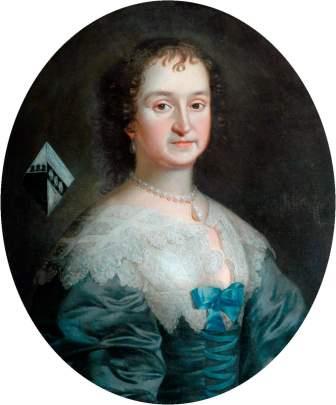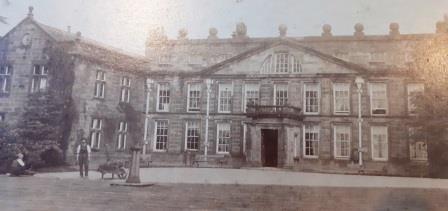Assistant Curator of Collections Dr Lauren Padgett tells us about how a family’s 18th century botanical gardens are now public woods in Bierley for Bradfordians to enjoy centuries later.
Anyone who wanders off the beaten track in Bierley Woods, Bradford, might stumble across the remains of stone steps and a wall. This was once the site of Bierley Hall, owned by the Richardson family. But who were the Richardsons and why was their house in the middle of Bierley Woods?

Richardson Family
In 1561, Nicholas Richardson left Durham to move to Bradford where he bought the Manor and Estates of Bierley. Down the ancestral line, William Richardson (born 1629, died 1667) married Susannah Savile of Greetland (b. unknown, d. 1708) in 1659. William and Susannah’s surviving eldest son was Richard. Let’s call him Richard Senior so we don’t confuse him with his namesake son later on. He was born in 1663 and went to Bradford Grammar School before attending the University of Oxford and the University of Leiden, Netherlands. In Leiden, Paul Hermann, a Professor of Botany, sowed the seeds of interest in plant biology within Richard Senior. He returned to Bradford and practiced as a doctor of medicine, often working pro bono locally. He travelled around Scotland, Wales and England collecting botanical specimens, becoming a leading botanist in mosses and native species. He married his first wife, Sarah, in 1699 who sadly passed away in 1702. He had a memorial cross for her built in Oakenshaw; this cross is still there today. He married his second wife, Dorothy, in 1705. Their son, Richard Junior, was born in 1708 and later followed his father’s footsteps, studying at Bradford Grammar School, becoming a doctor of medicine and also having a fascination with botany.

Bierley Hall
After Nicholas had bought the Manor and Estates of Bierley in 1561, a traditional 17th century manor house was built out of timber and plaster just off Bierley Lane. It was rebuilt around 1690 by Richard Senior, in a Dutch Renaissance style using stone. In 1718, Richard Senior built one of the first glasshouses or hothouses in Yorkshire, if not one of the first in England, within the grounds of Bierley Hall. It was used to grow non-native plants and exotic fruit, such as pineapples. Bierley Hall was later remodelled more classically by Richard Junior in the mid-18th century. Just prior to 1750, some of the Hall’s stained glass windows were removed and installed at Bolling Hall, where they remain today. Richard Junior had no heir when he died in 1781 so the estate was inherited by close relative Frances Mary Richardson Currer. She was a prolific book collector – a contemporary described her as ‘head of all female book collectors in Europe’ as she had one of England’s largest libraries. She inherited not only the Hall, grounds and Estate but, luckily for her, an entire library of botanical and historical publications. The Hall was tenanted in the 19th century before being bought by the Borough of Bradford in 1895. After 1895, Bierley Hall became an isolation hospital. It was given to the Ministry of Health in 1948 and continued to be a hospital until 1968, after which the Hall was demolished.



Bierley Woods
Bierley Woods is the botanical garden of Bierley Hall which Richard Senior and Richard Junior landscaped using their knowledge and interest in botany. Richard Senior had created traditional formal gardens at the front of Bierley Hall, but early in the 18th century, he started planting a large botanical garden, or woods, beyond that with almost 2,000 different species of trees. Of note were cedars of Lebanon which Richard Senior successfully cultivated after receiving seeds in 1721 from botanist Sir Hans Sloane. Richard Senior tried growing them in his glasshouse at first but they failed to grow so he planted several around the grounds. They grew too well as most of them had to be cut down in 1850 as they towered over the Hall. The last surviving cedar, reaching a height of 17 metres or 54 feet in height and 4.6 metres or 15 feet in circumference, was cut down in 1907 and its stump can still be found in the grounds, it is said. Richardson Junior is responsible for the most dramatic transformation of the grounds and for Bierley Woods’ unique features. He dammed the nearby steam to create cascading artificial ponds, and built a grotto (now blocked) and a ‘Druid circle’ or temple from stone quarried from Wibsey. It is believed that this work was completed by 1751. After Richardson Senior’s and Junior’s botanical and landscaping endeavour, the woods have been virtually untouched apart from the felling of the Lebanon cedars. Today, Bierley Woods is now a public wooded area and perfect for scenic walks and seeing a variety of wildlife.


4 Responses
I spend my youth in Bierley and Bierley Woods were always something special. I spent hours fishing in the lakes and the cave and the natural atmosphere was for a boy always an adventure.. I never knew the history of the Richardsons.
I spend my youth in Bierley and Bierley Woods were always something special. I spent hours fishing in the lakes and the cave and the natural atmosphere was for a boy always an adventure.. I never knew the history of the Richardsons.
Hi wow iv grown up in bierley and also fish in these wood and help out what nice photos thes are n what a nice quirt place very peaceful wen down there fishing plenty good members n good club be in
Hi does any one know what the round structed building with what looks like a wall round it above to the left of the steps in the grounds of Birley hall. ?